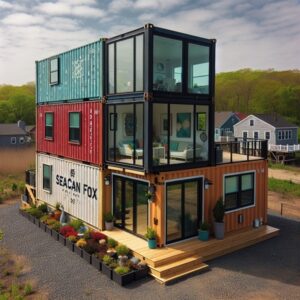
Key Takeaways
- Container homes are legal in Ontario, but you must comply with the Ontario Building Code and local zoning by-laws.
- A building permit is required for any structure over 10 square meters (108 square feet).
- Zoning by-laws vary by municipality; always check with local authorities.
- Safety standards include structural integrity, ventilation, and fire safety regulations.
- Non-compliance with setback rules can result in fines or removal orders.
Are Container Homes Legal In Ontario?
My Favorite Container Homes Resource
I compared the top 3 Container Home Guides
to discover the ultimate resource!
See my top recommendation here
Legality of Container Homes in Ontario at a Glance
Container homes have gained popularity due to their affordability and sustainability. In Ontario, they are considered legal structures, but you need to adhere to the Ontario Building Code and local zoning by-laws. Understanding these regulations is crucial to ensure your project is both legal and safe.
Understanding the Ontario Building Code
The Ontario Building Code sets the standards for construction, including container homes. It covers aspects like structural integrity, fire safety, and ventilation. These standards ensure that your container home is safe for habitation.
For instance, the code requires that any structure over 10 square meters (108 square feet) must have a building permit. This rule applies to container homes, whether they are used as primary residences or additional structures on your property.
Building Permits in Ontario
Obtaining a building permit is a critical step in the construction of your container home. This permit ensures that your project complies with all relevant regulations and standards.
When You Need a Building Permit
In Ontario, a building permit is necessary for any structure over 10 square meters. This includes:
- Primary residences
- Accessory structures like garages or storage units
- Temporary structures used for events or seasonal activities
Steps to Obtain a Building Permit
Getting a building permit involves several steps. Here’s a simplified guide:
If you are considering using shipping containers for your building project, make sure to check local regulations and requirements.
- Consult with local authorities to understand specific requirements for your area.
- Prepare detailed plans and specifications for your container home.
- Submit your application along with the necessary documents and fees.
- Undergo inspections to ensure compliance with the Ontario Building Code.
Zoning Requirements and Considerations
Zoning by-laws play a significant role in determining where you can place your container home. These regulations vary by municipality, so it’s essential to consult local authorities.
Municipal Zoning By-Laws
Each municipality in Ontario has its own zoning by-laws that dictate where container homes can be placed. These by-laws cover various aspects, including:
- Permitted zones for container homes (e.g., residential, commercial, industrial)
- Setback requirements from property lines
- Maximum height and size of structures
For example, some municipalities may allow container homes in rural areas but restrict them in urban settings. Always check with your local zoning office to understand the specific regulations in your area.
Commercial, Industrial, and Rural Zones
- Commercial Zones: Container homes may be allowed as accessory structures or temporary offices.
- Industrial Zones: Often more lenient, allowing for larger containers and multiple units.
- Rural Zones: Typically more flexible, offering greater freedom in terms of size and placement.
Safety Standards for Container Homes
Ensuring your container home meets safety standards is crucial for the well-being of its occupants. The Ontario Building Code sets out specific requirements to ensure these structures are safe and habitable.
Structural Integrity Requirements
One of the primary concerns for container homes is structural integrity. These homes must be designed to withstand various loads, including wind, snow, and occupancy loads. The Ontario Building Code provides guidelines to ensure the structural soundness of container homes.
“The Ontario Building Code recognizes shipping containers ranging from 160 to 320 square feet as structures when used on land.”
To meet these requirements, you may need to reinforce the container’s structure, especially if you plan to cut openings for windows and doors. Consulting with a structural engineer can help you ensure your design meets all necessary standards.
Ventilation and Climate Control Standards
Proper ventilation and climate control are essential for maintaining a comfortable living environment in a container home. The Ontario Building Code specifies requirements for heating, ventilation, and air conditioning (HVAC) systems to ensure adequate airflow and temperature regulation.
For example, you must install proper
Fire Safety Regulations
Fire safety is another critical aspect of building a container home. The Ontario Building Code includes regulations to minimize fire risks and ensure the safety of occupants. These regulations cover aspects such as fire-resistant materials, smoke detectors, and escape routes.
For instance, you may need to use fire-resistant insulation and install smoke detectors in key areas of the home. Additionally, having clearly marked escape routes can make a significant difference in case of an emergency.
Container Homes Laws & Regulations In Ontario Summary
References:
https://storage-tech.ca/ontario-container-home-laws/
https://storage-tech.ca/can-i-put-a-container-on-my-land-ontario/
https://www.reddit.com/r/containerhomes/comments/69u4qv/legal_in_ontario_canada/
https://www.hamilton.ca/city-council/news-notices/news-releases/shipping-containers-subject-ontario-building-code-city

Setback Rules and Property Line Regulations
Setback rules and property line regulations dictate how far your container home must be from property lines, roads, and other structures. These rules are designed to ensure safety, privacy, and accessibility. For those looking to purchase a container home, you can explore options for new and used shipping containers.
Minimum Distance Requirements
In Ontario, setback requirements vary by municipality. Typically, you must maintain a minimum distance from property lines, which can range from a few meters to several dozen meters. These distances are essential for fire safety, access for emergency services, and maintaining a harmonious neighborhood.
“Non-compliance with setback rules can result in fines or removal orders from local authorities.”
It’s crucial to consult your local zoning office to understand the specific setback requirements for your area. Failing to comply with these rules can lead to costly fines and even the removal of your container home.
Consequences of Non-Compliance
Non-compliance with setback rules and property line regulations can have severe consequences. Besides fines and removal orders, you may face difficulties in selling or insuring your property. Ensuring compliance from the outset can save you time, money, and stress in the long run.
Therefore, always check with local authorities and obtain the necessary permits before starting your container home project. This proactive approach will help you avoid legal issues and ensure your home is a safe and enjoyable place to live.
Inspection Processes
Inspections are a crucial part of the building process for container homes in Ontario. These inspections ensure that your home complies with all relevant regulations and standards.
Initial Inspection Requirements
The initial inspection typically occurs after you submit your building permit application. During this inspection, local building inspectors will review your plans and specifications to ensure they meet the Ontario Building Code and local zoning by-laws.
“Companies like Secure Container offer insights into the inspection process for shipping container structures in Ontario.”
Once your plans are approved, you can proceed with the construction of your container home. It’s essential to follow the approved plans closely to avoid any issues during subsequent inspections. For more details on the regulations, you can refer to the Ontario Building Code.
Ongoing Compliance Checks
After the initial inspection, ongoing compliance checks ensure that your container home continues to meet all relevant standards. These checks may occur at various stages of construction, including foundation work, framing, and final completion.
During these inspections, building inspectors will verify that your construction practices and materials comply with the Ontario Building Code. Any deviations from the approved plans may require corrections before you can proceed further.
Maintaining open communication with local authorities and inspectors can help you navigate these compliance checks smoothly. By staying proactive and addressing any issues promptly, you can ensure your container home project stays on track.
Case Studies and Examples
Real-life examples can provide valuable insights and inspiration for your container home project. Let’s look at some successful container homes in Ontario and the challenges they faced and overcame.
Conclusion
Key Findings and Recommendations
Building a container home in Ontario is a viable and exciting option, but it requires careful planning and adherence to regulations. Key takeaways include the importance of obtaining building permits, understanding local zoning by-laws, and ensuring compliance with safety standards.
By consulting with local authorities, obtaining the necessary permits, and following the Ontario Building Code, you can create a safe and functional container home. Additionally, learning from successful projects and overcoming challenges can help you navigate the process smoothly.

Frequently Asked Questions (FAQ)
Are container homes allowed in urban areas of Ontario?
Yes, container homes are allowed in urban areas of Ontario, but they must comply with local zoning by-laws and the Ontario Building Code. Always check with your local zoning office to understand the specific regulations for your area.
What are the primary safety concerns with container homes?
The primary safety concerns with container homes include structural integrity, proper ventilation, and fire safety. Ensuring compliance with the Ontario Building Code and consulting with experts can help address these concerns.
How long does it take to get a building permit for a container home?
The time it takes to get a building permit for a container home can vary depending on the complexity of your project and the efficiency of your local building department. On average, it can take several weeks to a few months. If you are considering using new or used shipping containers for your project, make sure to check local regulations and requirements.
What are the costs associated with getting permits and inspections?
The costs associated with getting permits and inspections for a container home can vary. Building permit fees typically range from a few hundred to a few thousand dollars, depending on the size and scope of your project. Inspection fees may be included in the permit cost or charged separately.
Can container homes be used as primary residences in Ontario?
Yes, container homes can be used as primary residences in Ontario, provided they comply with the Ontario Building Code and local zoning by-laws. Obtaining the necessary permits and ensuring compliance with safety standards are essential steps in making a container home your primary residence.
Building a container home in Ontario is an exciting prospect. However, it’s essential to understand the legal landscape before diving in. Container homes are legal in Ontario, but you must comply with specific regulations and requirements. Let’s break down what you need to know.






Leave a Reply